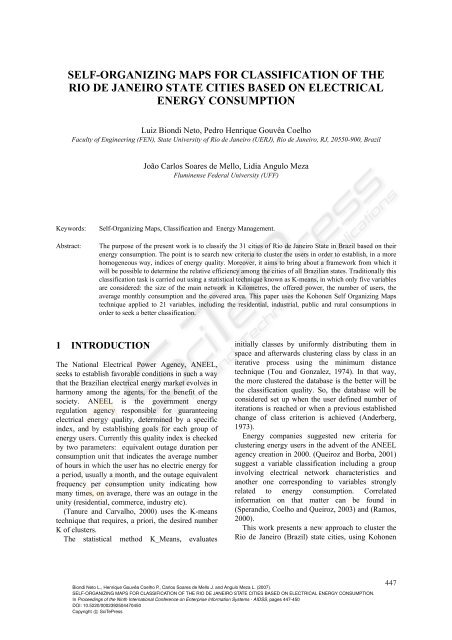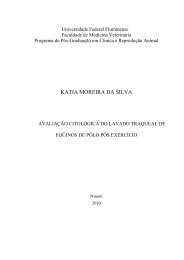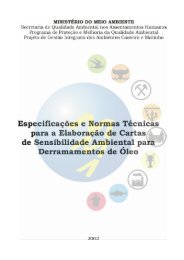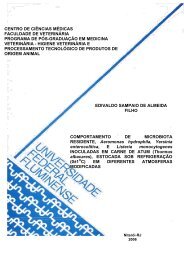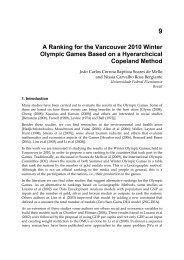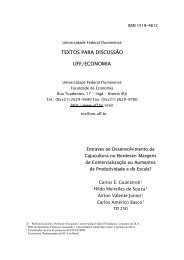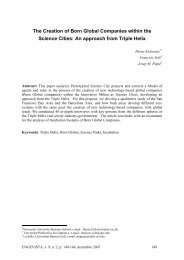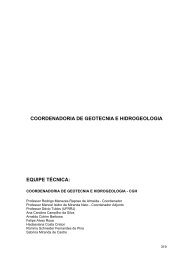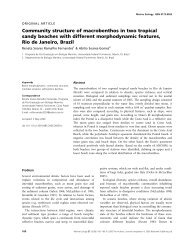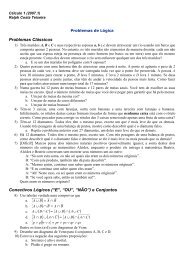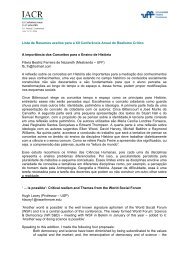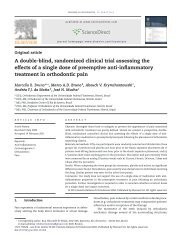self-organizing maps for classification of the rio de janeiro ... - UFF
self-organizing maps for classification of the rio de janeiro ... - UFF
self-organizing maps for classification of the rio de janeiro ... - UFF
You also want an ePaper? Increase the reach of your titles
YUMPU automatically turns print PDFs into web optimized ePapers that Google loves.
SELF-ORGANIZING MAPS FOR CLASSIFICATION OF THE<br />
RIO DE JANEIRO STATE CITIES BASED ON ELECTRICAL<br />
ENERGY CONSUMPTION<br />
Luiz Biondi Neto, Pedro Henrique Gouvêa Coelho<br />
Faculty <strong>of</strong> Engineering (FEN), State University <strong>of</strong> Rio <strong>de</strong> Janeiro (UERJ), Rio <strong>de</strong> Janeiro, RJ, 20550-900, Brazil<br />
João Carlos Soares <strong>de</strong> Mello, Lidia Angulo Meza<br />
Fluminense Fe<strong>de</strong>ral University (<strong>UFF</strong>)<br />
Keywords:<br />
Abstract:<br />
Self-Organizing Maps, Classification and Energy Management.<br />
The purpose <strong>of</strong> <strong>the</strong> present work is to classify <strong>the</strong> 31 cities <strong>of</strong> Rio <strong>de</strong> Janeiro State in Brazil based on <strong>the</strong>ir<br />
energy consumption. The point is to search new criteria to cluster <strong>the</strong> users in or<strong>de</strong>r to establish, in a more<br />
homogeneous way, indices <strong>of</strong> energy quality. Moreover, it aims to bring about a framework from which it<br />
will be possible to <strong>de</strong>termine <strong>the</strong> relative efficiency among <strong>the</strong> cities <strong>of</strong> all Brazilian states. Traditionally this<br />
<strong>classification</strong> task is carried out using a statistical technique known as K-means, in which only five variables<br />
are consi<strong>de</strong>red: <strong>the</strong> size <strong>of</strong> <strong>the</strong> main network in Kilometres, <strong>the</strong> <strong>of</strong>fered power, <strong>the</strong> number <strong>of</strong> users, <strong>the</strong><br />
average monthly consumption and <strong>the</strong> covered area. This paper uses <strong>the</strong> Kohonen Self Organizing Maps<br />
technique applied to 21 variables, including <strong>the</strong> resi<strong>de</strong>ntial, industrial, public and rural consumptions in<br />
or<strong>de</strong>r to seek a better <strong>classification</strong>.<br />
1 INTRODUCTION<br />
The National Electrical Power Agency, ANEEL,<br />
seeks to establish favorable conditions in such a way<br />
that <strong>the</strong> Brazilian electrical energy market evolves in<br />
harmony among <strong>the</strong> agents, <strong>for</strong> <strong>the</strong> benefit <strong>of</strong> <strong>the</strong><br />
society. ANEEL is <strong>the</strong> government energy<br />
regulation agency responsible <strong>for</strong> guaranteeing<br />
electrical energy quality, <strong>de</strong>termined by a specific<br />
in<strong>de</strong>x, and by establishing goals <strong>for</strong> each group <strong>of</strong><br />
energy users. Currently this quality in<strong>de</strong>x is checked<br />
by two parameters: equivalent outage duration per<br />
consumption unit that indicates <strong>the</strong> average number<br />
<strong>of</strong> hours in which <strong>the</strong> user has no electric energy <strong>for</strong><br />
a pe<strong>rio</strong>d, usually a month, and <strong>the</strong> outage equivalent<br />
frequency per consumption unity indicating how<br />
many times, on average, <strong>the</strong>re was an outage in <strong>the</strong><br />
unity (resi<strong>de</strong>ntial, commerce, industry etc).<br />
(Tanure and Carvalho, 2000) uses <strong>the</strong> K-means<br />
technique that requires, a p<strong>rio</strong>ri, <strong>the</strong> <strong>de</strong>sired number<br />
K <strong>of</strong> clusters.<br />
The statistical method K_Means, evaluates<br />
initially classes by uni<strong>for</strong>mly distributing <strong>the</strong>m in<br />
space and afterwards clustering class by class in an<br />
iterative process using <strong>the</strong> minimum distance<br />
technique (Tou and Gonzalez, 1974). In that way,<br />
<strong>the</strong> more clustered <strong>the</strong> database is <strong>the</strong> better will be<br />
<strong>the</strong> <strong>classification</strong> quality. So, <strong>the</strong> database will be<br />
consi<strong>de</strong>red set up when <strong>the</strong> user <strong>de</strong>fined number <strong>of</strong><br />
iterations is reached or when a previous established<br />
change <strong>of</strong> class crite<strong>rio</strong>n is achieved (An<strong>de</strong>rberg,<br />
1973).<br />
Energy companies suggested new criteria <strong>for</strong><br />
clustering energy users in <strong>the</strong> advent <strong>of</strong> <strong>the</strong> ANEEL<br />
agency creation in 2000. (Queiroz and Borba, 2001)<br />
suggest a variable <strong>classification</strong> including a group<br />
involving electrical network characteristics and<br />
ano<strong>the</strong>r one corresponding to variables strongly<br />
related to energy consumption. Correlated<br />
in<strong>for</strong>mation on that matter can be found in<br />
(Sperandio, Coelho and Queiroz, 2003) and (Ramos,<br />
2000).<br />
This work presents a new approach to cluster <strong>the</strong><br />
Rio <strong>de</strong> Janeiro (Brazil) state cities, using Kohonen<br />
Biondi Neto L., Henrique Gouvêa Coelho P., Carlos Soares <strong>de</strong> Mello J. and Angulo Meza L. (2007).<br />
SELF-ORGANIZING MAPS FOR CLASSIFICATION OF THE RIO DE JANEIRO STATE CITIES BASED ON ELECTRICAL ENERGY CONSUMPTION.<br />
In Proceedings <strong>of</strong> <strong>the</strong> Ninth International Conference on Enterprise In<strong>for</strong>mation Systems - AIDSS, pages 447-450<br />
DOI: 10.5220/0002392504470450<br />
Copyright c○ SciTePress<br />
447
ICEIS 2007 - International Conference on Enterprise In<strong>for</strong>mation Systems<br />
map unsupervised algorithms (Kohonen, 2001)<br />
where <strong>the</strong> previous specification <strong>of</strong> <strong>the</strong> number <strong>of</strong><br />
clusters is not required.<br />
Unlike <strong>the</strong> Hebbian neural networks, in Kohonen<br />
competitive and unsupervised learning neural<br />
networks, only one output neuron remains active and<br />
each neuron represents a mo<strong>de</strong>l in <strong>the</strong> data state<br />
space. In that case, no mapping or data input<br />
<strong>classification</strong> is known be<strong>for</strong>e <strong>the</strong> training (Haykin,<br />
1999). Clusters are <strong>de</strong>veloped in <strong>the</strong> training pe<strong>rio</strong>d<br />
by means <strong>of</strong> similarity criteria indicating similar<br />
features pattern clusters.<br />
Each input neuron receives i<strong>de</strong>ntical sets <strong>of</strong> input<br />
in<strong>for</strong>mation that compete each o<strong>the</strong>r in or<strong>de</strong>r to be<br />
<strong>the</strong> winning neuron. In o<strong>the</strong>r words, each neuron<br />
focus in a different area <strong>of</strong> <strong>the</strong> input space and its<br />
output are used to generate <strong>the</strong> input space structure<br />
(Haykin, 1999).<br />
The s<strong>of</strong>tware used in this work was Matlab 7.0<br />
including <strong>the</strong> toolbox SOM (<strong>self</strong>-<strong>organizing</strong> <strong>maps</strong>)<br />
(Kohonen, Hynninen, Kangas, Laaksonen, 1996)<br />
<strong>de</strong>veloped by Helsinki University <strong>of</strong> Technology.<br />
achieve a data set represented by a matrix 91X21<br />
that is not shown in this paper <strong>for</strong> <strong>the</strong> sake <strong>of</strong> space<br />
optimization and readability.<br />
The matrix is <strong>the</strong>n set to be <strong>the</strong> input <strong>of</strong> <strong>the</strong><br />
competitive SOM yielding 21 inputs regarding <strong>the</strong><br />
variables corresponding to <strong>the</strong> 91 investigated cities.<br />
3 RESULTS<br />
Thirty SOM networks having grids <strong>of</strong> different<br />
dimensions were tested in or<strong>de</strong>r to check <strong>the</strong><br />
clustering achieved by <strong>the</strong> Kohonen <strong>maps</strong>. A<br />
hexagonal topology was used and a learning rate<br />
varied from 0.01 to 0.1 with unity neighbourhood.<br />
This paper presents <strong>the</strong> results <strong>of</strong> networks with<br />
[6X6] grids, enabling up to 36 clusters and [3X3]<br />
grids enabling up to 9 clusters.<br />
Figure 1 shows a configuration <strong>for</strong> a [6X6] grid.<br />
[6 x 6]<br />
2 PROBLEM DESCRIPTION AND<br />
MODELLING<br />
The problem is to classify <strong>the</strong> cities <strong>of</strong> Rio <strong>de</strong><br />
Janeiro state (Brazil) in groups <strong>of</strong> cities with similar<br />
pr<strong>of</strong>iles as far as electrical energy <strong>de</strong>mands are<br />
concerned. There is no previous knowledge <strong>of</strong> such<br />
<strong>classification</strong> nor <strong>the</strong>re are no restrictions regarding<br />
<strong>the</strong> number <strong>of</strong> <strong>de</strong>sired clusters.<br />
The database used in this application comprises<br />
91 cities <strong>of</strong> <strong>the</strong> Rio <strong>de</strong> Janeiro state. The cities are<br />
not listed by name but will i<strong>de</strong>ntified by numbers<br />
from 1 to 91<br />
For each city <strong>the</strong>re is a set <strong>of</strong> 21 variables<br />
involving:<br />
• Monthly consumption;<br />
• Resi<strong>de</strong>ntial consumption;<br />
• Industrial consumption;<br />
• Commercial consumption;<br />
• Rural consumption;<br />
• Public illumination consumption;<br />
• Public services consumption;<br />
• Public power consumption;<br />
• Self consumption;<br />
• Overall or total consumption.<br />
The data were treated statistically in <strong>the</strong> beginning<br />
so as to avoid missing values, outliers and strongly<br />
correlated values. In <strong>the</strong> end, it was possible to<br />
Figure 1: [6 X 6] Grid.<br />
The results are <strong>the</strong> following:<br />
Grid [6 x 6] ( 27 clusters were found )<br />
Cluster #01 (26 cities): 02-04-14-17-18-21-22-<br />
24-26-31-36-38-45-55-57-59-61-64-65-68-75-<br />
78-82-83-86-89<br />
Cluster #02 (07 cities): 20-28-32-43-44-53-70<br />
Cluster #03 (04 cities): 05-77-80-88<br />
Cluster #04 (03 cities): 03-39-46<br />
Cluster #05 (01 cities): 48<br />
Cluster #06 (01 cities): 60<br />
Cluster #07 (05 cities): 10-19-23-76-79<br />
Cluster #08 (06 cities): 35-52-63-66-81-90<br />
Cluster #09 (02 cities): 33-41<br />
Cluster #11 (03 cities): 09-15-74<br />
Cluster #13 (06 cities): 06-11-42-71-73-84<br />
Cluster #14 (02 cities): 50-51<br />
Cluster #15 (01 cities): 30<br />
Cluster #16 (04 cities): 01-12-29-85<br />
Cluster #17 (01 cities): 54<br />
Cluster #18 (01 cities): 49<br />
Cluster #19 (03 cities): 13-40-69<br />
448
SELF-ORGANIZING MAPS FOR CLASSIFICATION OF THE RIO DE JANEIRO STATE CITIES BASED ON<br />
ELECTRICAL ENERGY CONSUMPTION<br />
Cluster #20 (01 cities): 87<br />
Cluster #21 (03 cities): 07-37-62<br />
Cluster #23 (02 cities): 25-72<br />
Cluster #24 (01 cities): 47<br />
Cluster #25 (03 cities): 27-34-58<br />
Cluster #26 (01 cities): 56<br />
Cluster #28 (01 cities: 08<br />
Cluster #32 (01 cities): 16<br />
Cluster #34 (01 cities): 91<br />
Cluster #36 (01 cities): 67<br />
In this case although cluster 01 comprises 26<br />
cities, 12 clusters were found having only one city<br />
and 03 clusters having 02 cities, suggesting<br />
improvements.<br />
The U-matrix, represented in Fig. 2, shows<br />
Euclidian distances by means <strong>of</strong> a colour coding.<br />
same occurs with clusters #04, #16 e #20 <strong>of</strong> grid [6<br />
x 6], yielding cluster #04 <strong>of</strong> grid [3 x 3].<br />
However <strong>the</strong>re are still 2 clusters with only one<br />
city. Figure 3 shows <strong>the</strong> U-matrix <strong>for</strong> a [3 x 3] grid.<br />
U-matrix<br />
3.25<br />
1.72<br />
0.181<br />
U-matrix<br />
19.1<br />
Figure 3: U-Matrix <strong>for</strong> a [3X3] Grid.<br />
Figure 4 <strong>de</strong>picts a comparison between resi<strong>de</strong>ntial and<br />
rural consumption.<br />
9.66<br />
3.98e+006<br />
15200<br />
Resi<strong>de</strong>ntial<br />
Rural<br />
0.202<br />
2.01e+006<br />
7930<br />
Figure 2: U-Matrix <strong>for</strong> a [6X6] Grid.<br />
Grid [3 x 3] (08 clusters were found)<br />
Cluster #01 (06 cities): 09-16-29-37-48-62<br />
Cluster #02 (05 cities): 08-15-54-60-74<br />
Cluster #03 (01 cities): 91<br />
Cluster #04 (10 cities): 01-03-07-12-30-39-46-<br />
56-85-87<br />
Cluster #05 (04 cities): 25-47-49-72<br />
Cluster #06 (01 city): 67<br />
Cluster #07 (55 cities): 02-04-05-06-10-11-13-<br />
14-17-18-19-20-21-22-23-24-26-28-31-32-35-<br />
36-38-42-43-44-45-50-51-52-53-55-57-59-61-<br />
63-64-65-66-68-69-70-71-73-75-76-78-79-81-<br />
82-83-84-86-89-90<br />
Cluster #08 (09 cities): 27-33-34-40-41-58-77-<br />
80-88<br />
In [3 x 3] grid , Clusters #01, #02, #07, #13 e #14<br />
<strong>of</strong> grid [6 x 6] are almost joined establishing cluster<br />
07. The clusters #03, #09 and #25 <strong>of</strong> cluster [6 x 6],<br />
also joined yielding cluster #08 <strong>of</strong> grid [3 x 3]. The<br />
44300<br />
Finally Fig. 5 shows all variables involved in <strong>the</strong><br />
investigated case and allows an overview <strong>of</strong> <strong>the</strong><br />
clustering problem.<br />
4 CONCLUSIONS<br />
619<br />
d<br />
Figure 4: Resi<strong>de</strong>ntial and Rural Consumption Comparison.<br />
The Kohonen neural nets constitute a very efficient<br />
method <strong>for</strong> clustering. The results were shown by<br />
means <strong>of</strong> graphs which indicate easily <strong>the</strong> changes in<br />
<strong>the</strong> groups occurring during <strong>the</strong> clustering <strong>for</strong>mation.<br />
Clustering is done within a large amount <strong>of</strong> data,<br />
characterized by several variables in which many <strong>of</strong><br />
449
ICEIS 2007 - International Conference on Enterprise In<strong>for</strong>mation Systems<br />
U-matrix JAN FEB MAR APR<br />
MAY JUN JUL AUG SEP<br />
OCT NOV DEC RESIDENTIAL INDUSTRIAL<br />
COMMERCIAL RURAL P. ILLUMINATION P. SERVICES P. POWER<br />
S. CONSUMPTION TOTAL<br />
Figure 5: Overview <strong>of</strong> <strong>the</strong> Clustering Problem.<br />
<strong>the</strong>m show similarities. The results are presented in<br />
2D <strong>maps</strong>.<br />
The trouble in clustering <strong>the</strong> cities <strong>of</strong> Rio <strong>de</strong><br />
Janeiro (67) and Volta Redonda (91) was due to <strong>the</strong><br />
fact that both showed energy consumption above<br />
average, making <strong>the</strong>m different from <strong>the</strong> o<strong>the</strong>rs. As a<br />
matter <strong>of</strong> fact, Rio <strong>de</strong> Janeiro shows large energy<br />
consumption in all variables except rural<br />
consumption. Volta Redonda also shows this<br />
characteristic in less volume but significantly in <strong>the</strong><br />
industrial energy consumption due to its steel<br />
industry.<br />
Although <strong>the</strong> results given by <strong>the</strong> Kohonen neural<br />
nets showed a great <strong>de</strong>al <strong>of</strong> homogeneity in <strong>the</strong><br />
clustering <strong>for</strong>mation, it is expected a <strong>classification</strong><br />
improvement if more variables are inserted such as<br />
<strong>the</strong> city area, number <strong>of</strong> inhabitants and some<br />
economical variable e. g. per capita income.<br />
using <strong>self</strong>-<strong>organizing</strong> <strong>maps</strong>. In Proceedings <strong>of</strong> <strong>the</strong> V<br />
SBQEE, Aracaju - Brazil, in Portuguese.<br />
Ramos, A. J. P., 2000. Control and assessment <strong>of</strong><br />
electrical energy quality. In Technical Report 2 –<br />
Monitoring and Instrumentation Protocol, in<br />
Portuguese.<br />
Kohonen, T., 2001. Self-<strong>organizing</strong> <strong>maps</strong>. 3rd ed.<br />
Springer-Verlag, Berlin.<br />
Haykin, S. , 2001. Neural networks: a comprehensive<br />
foundation. Prentice Hall, 2nd ed., Upper Saddle<br />
River: New Jersey.<br />
Kohonen, T., Hynninen, J., Kangas J., Laaksonen J., 1996.<br />
SOM_PAK: The <strong>self</strong>-<strong>organizing</strong> map program<br />
package, Technical Report A31. In Technical Report<br />
A31, Helsinki University <strong>of</strong> Technology, 1996,<br />
available in http://www.cis.hut.fi/nnrc/nnrcprograms.html.<br />
Willshaw, W. D. J., Buneman, O. P., Longuet-Higgins, H.<br />
C., 1969. Non-holographic associative memory. In<br />
Nantre, London, voI.222, pp.960-962.<br />
Willshaw, D. J., von <strong>de</strong>r Malsburg ,C., 1976. How<br />
patterned neural connections can be set up by <strong>self</strong>organization.<br />
In Proceedings <strong>of</strong> <strong>the</strong> Royal Society <strong>of</strong><br />
London Series B. voI.194, pp.431-445.<br />
Dry<strong>de</strong>n, I.. L. , Mardia, K.V., 1998. Statistical shape<br />
analysis. John Wiley: Chichester.<br />
Michie, D., Spiegelhalter D. J., Taylor, C. C., 1994.<br />
Machine learning, neural and statistical <strong>classification</strong>.<br />
Ellis Horwood, pp. 35-36.<br />
Akkus, A., Guvernir H. A., 1996. K-Nearest neighbour<br />
<strong>classification</strong> on feature projections. In Proceedings <strong>of</strong><br />
ICML’96 Lorenza Saitta (ed.). Proceedings <strong>of</strong> ICML<br />
1996, Bari, Italy.<br />
Mitra, P., Murthy, C.A., Pal , S.K., 2002. Unsupervised<br />
feature election using feature similarity. In IEEE<br />
Transactions on Pattern Analysis and Machine<br />
Intelligence, vol. 24, no. 3.<br />
Bishop, C. M., 1995. Neural networks <strong>for</strong> pattern<br />
recognition. New York, Ox<strong>for</strong>d University Press.<br />
REFERENCES<br />
Tanure, J.E,P.S., Carvalho, E.B., 2000. Regulation by<br />
per<strong>for</strong>mance comparison <strong>for</strong> establishing goals <strong>for</strong><br />
continuity in energy dispensing. In National Workshop<br />
on Electrical Energy Distribution, Foz <strong>de</strong> Iguaçu,<br />
Brazil, 2000, in Portuguese.<br />
Tou, J. T., 1974. Pattern recognition principles. Addison-<br />
Wesley Publishing Company. Massachusetts, 2 nd<br />
edition.<br />
An<strong>de</strong>rberg, M.R. 1973. Cluster analysis <strong>for</strong> applications.<br />
Aca<strong>de</strong>mic Press.<br />
Queiroz, H. L., Borba, C. M., 2001. Methodology <strong>for</strong> set<br />
evaluation by means <strong>of</strong> quality technical indices. In<br />
Electrical Energy Distribution Systems, Puerto<br />
Iguaçu, Argentina, in Portuguese.<br />
Sperandio, M., Coelho, J., Queiroz, H. L. , 2003.<br />
I<strong>de</strong>ntification <strong>of</strong> clusters <strong>of</strong> energy consumption users<br />
450


